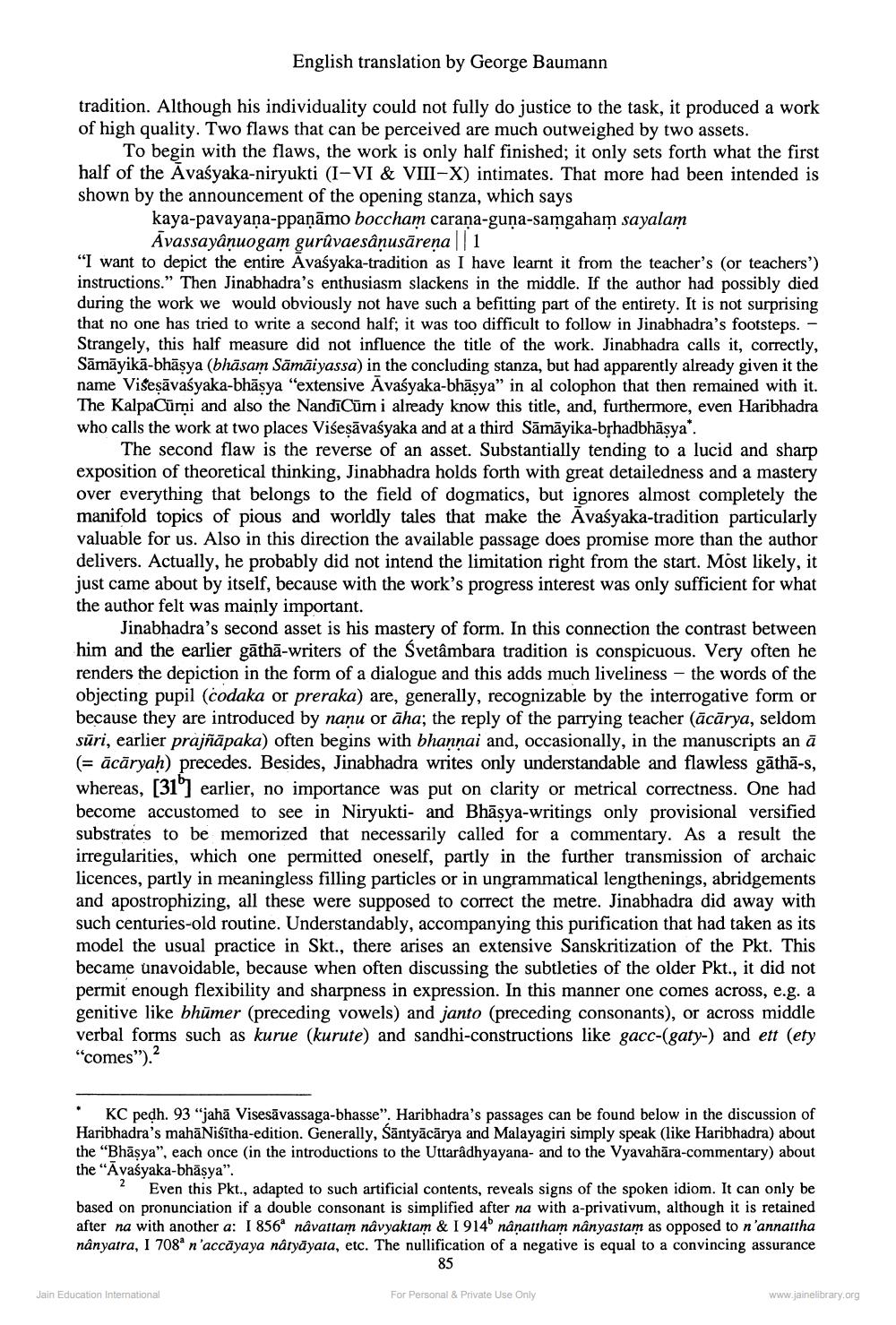________________
English translation by George Baumann
tradition. Although his individuality could not fully do justice to the task, it produced a work of high quality. Two flaws that can be perceived are much outweighed by two assets.
To begin with the flaws, the work is only half finished; it only sets forth what the first half of the Avaśyaka-niryukti (I-VI & VIII-X) intimates. That more had been intended is shown by the announcement of the opening stanza, which says
kaya-pavayaņa-ppaņāmo boccham carana-guna-samgaham sayalam
Avassayânuogam gurûvaesânusārena || 1 "I want to depict the entire Avaśyaka-tradition as I have learnt it from the teacher's (or teachers') instructions." Then Jinabhadra's enthusiasm slackens in the middle. If the author had possibly died during the work we would obviously not have such a befitting part of the entirety. It is not surprising that no one has tried to write a second half; it was too difficult to follow in Jinabhadra's footsteps. - Strangely, this half measure did not influence the title of the work. Jinabhadra calls it, correctly, Sāmāyikā-bhāsya (bhāsam Sāmāiyassa) in the concluding stanza, but had apparently already given it the name Viseşāvaśyaka-bhāsya "extensive Avaśyaka-bhāsya" in al colophon that then remained with it. The KalpaCūmi and also the NandiCūrn i already know this title, and, furthermore, even Haribhadra who calls the work at two places Viseşāvaśyaka and at a third Sāmāyika-brhadbhāsya".
The second flaw is the reverse of an asset. Substantially tending to a lucid and sharp exposition of theoretical thinking, Jinabhadra holds forth with great detailedness and a mastery over everything that belongs to the field of dogmatics, but ignores almost completely the manifold topics of pious and worldly tales that make the Avaśyaka-tradition particularly valuable for us. Also in this direction the available passage does promise more than the author delivers. Actually, he probably did not intend the limitation right from the start. Most likely, it just came about by itself, because with the work's progress interest was only sufficient for what the author felt was mainly important.
Jinabhadra's second asset is his mastery of form. In this connection the contrast between him and the earlier gāthā-writers of the Svetâmbara tradition is conspicuous. Very often he renders the depiction in the form of a dialogue and this adds much liveliness – the words of the objecting pupil (codaka or preraka) are, generally, recognizable by the interrogative form or because they are introduced by nanu or āha; the reply of the parrying teacher (ācārya, seldom sūri, earlier prajñāpaka) often begins with bhannai and, occasionally, in the manuscripts an ā (= ācāryah) precedes. Besides, Jinabhadra writes only understandable and flawless gāthā-s, whereas, [31°) earlier, no importance was put on clarity or metrical correctness. One had become accustomed to see in Niryukti- and Bhāsya-writings only provisional versified substrates to be memorized that necessarily called for a commentary. As a result the irregularities, which one permitted oneself, partly in the further transmission of archaic licences, partly in meaningless filling particles or in ungrammatical lengthenings, abridgements and apostrophizing, all these were supposed to correct the metre. Jinabhadra did away with such centuries-old routine. Understandably, accompanying this purification that had taken as its model the usual practice in Skt., there arises an extensive Sanskritization of the Pkt. This became unavoidable, because when often discussing the subtleties of the older Pkt., it did not permit enough flexibility and sharpness in expression. In this manner one comes across, e.g. a genitive like bhūmer (preceding vowels) and janto (preceding consonants), or across middle verbal forms such as kurue (kurute) and sandhi-constructions like gacc-(gaty-) and ett (ety "comes").
KC pedh. 93 "jahā Visesāvassaga-bhasse". Haribhadra's passages can be found below in the discussion of Haribhadra's mahāNisītha-edition. Generally, Sāntyācārya and Malayagiri simply speak (like Haribhadra) about the "Bhāşya", each once in the introductions to the Uttaradhyayana- and to the Vyavahāra-commentary) about the "Avaśyaka-bhāsya".
? Even this Pkt., adapted to such artificial contents, reveals signs of the spoken idiom. It can only be based on pronunciation if a double consonant is simplified after na with a-privativum, although it is retained after na with another a: I 856 nåvattam nâvyaktam & 1914 nânattham nânyastam as opposed to n'annattha nânyatra, I 7089 n'accāyaya natyāyata, etc. The nullification of a negative is equal to a convincing assurance
85
Jain Education International
For Personal & Private Use Only
www.jainelibrary.org




